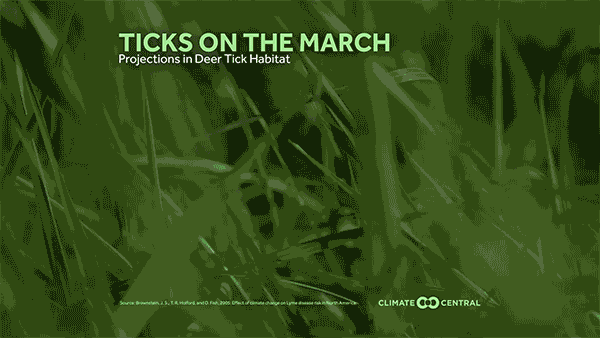

Ticks are not just pests, they also carry diseases. As we are nearing peak tick season, this week’s Climate Matters looks at how climate change is altering tick behavior, and with it, increasing the risk of humans being exposed to diseases.
The deer tick is the primary carrier of Lyme disease in the eastern U.S., though cases of the disease are not equally spread across the region. In 2015, 95% of Lyme disease cases reported were in northern states. A combination of reforestation in the Northeast, development near wooded areas, more people spending time outside and rising populations of hosts such as deer may all be playing a role.
But deer ticks do not appear to behave the same way in all parts of the country. One reason for the differing behavior appears to be related to relative humidity. As temperatures climb from the increase in greenhouse gases, there is an increase in overall humidity. In a recent study, deer ticks died faster when relative humidity was moderate (75%), but survived longer under high humidity (85%-95%).
The Northeast, which is becoming warmer and more humid, is providing an environment increasingly more conducive for ticks to venture up from the ground. That makes it more likely that they’ll latch onto a human and transmit Lyme disease. A different picture is emerging in the Southeast, though.
There’s a lower risk for Lyme disease there. Like in the Northeast, the level of humidity may also be a factor. Because ticks thrive in high humidity environments, ticks may be living closer to the ground in the Southeast — the same study found that southern populations of younger deer ticks often remain closer to the higher humidity associated with decaying leaves at the ground.
There has also been a net decrease in annual precipitation there, which may be leading to lower relative humidity and reducing tick activity.
The news is not all good for the Southeast. Another species, called Lone Star ticks, carries ehrlichiosis, a disease which also causes fatigue and aches. Cases in the U.S. are on the rise, and they’re found mostly in the Southeast. Research is underway by the Department of Defense to determine how climate change, invasive grasses, and fires are affecting tick populations and the diseases that they carry.
Looking toward the future, a warming world is going to change where habitats are suitable for disease-carrying ticks. Lyme disease-carrying deer ticks are likely to become more common as well. Populations are projected to increase nearly twofold in the U.S. and up to fivefold in Canada as warmer and more humid weather becomes more common.

